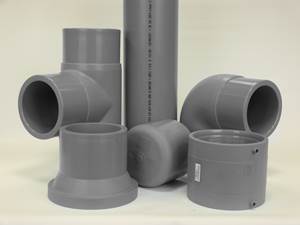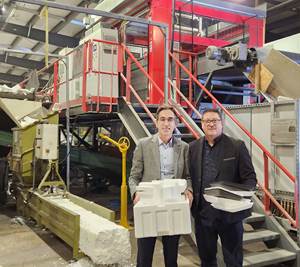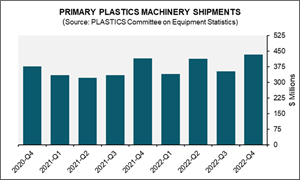Construction Activity to Increase
Wood on Plastics
Residential home spending up 20% over first three quarters compared to 2012.
Each quarter, the Federal Reserve conducts a nationwide survey of senior loan officers that asks their opinion on the changes in lending standards and the changes in demand for credit at their respective banks. The fourth-quarter survey indicates that bank standards for commercial and industrial loans as well as prime residential mortgages continue to loosen.
This is good news for the construction sector. By now everyone is aware that interest rates are at historically low levels, but the positive effects of these historically low rates have been mitigated by the fact that too few people have been able to qualify for a loan. This has been one of the most serious constraints on recovery of the U.S. economy.
According to the Fed survey, demand from large and medium borrowers for commercial and industrial loans was a bit higher in the fourth quarter when compared with the previous quarter, while demand from small borrowers was flat. This followed three consecutive quarters of vigorous increases in demand for commercial and industrial loads from borrowers of all sizes.
The bad news in the fourth-quarter survey is that demand for residential mortgages declined at the end of 2013. Demand for residential mortgages has grown at a robust pace for most of the past two years, but the survey data indicate that demand declined modestly in Q4. You will recall that interest rates ticked up for a brief period during the fourth quarter, but the real economic damage followed shortly thereafter when the federal government was shut down for a few days. The combination of these actions took a bite out of the wallets of government workers and dealt a serious blow to confidence levels for everyone else.
The longer-term trends in the senior loan officer survey are corroborated by the data on U.S. construction spending compiled and reported by the Census Bureau. Total construction spending was up by 6% through the first three quarters of 2013, but there is a strong divergence in growth rates among the various types of construction categories. Spending for residential projects is up a stellar 20% over the previous year, but nonresidential spending is only up 2%.
Much of this sluggishness in the nonresidential data so far this year is due to the predictable decreases in most types of government spending. The decreases in federal spending due to the sequester are well publicized, but the overall declines in state and local spending are also a drag at present. There are many who believe that government projects should be fast-tracked in order to take advantage of historically low interest rates.
As I mentioned earlier, the problem in the private sector has been a lack of access to credit, not political ineptitude. It finally looks like this is changing at a quicker pace. Taking a closer look at the nonresidential private sector it is clear that not all of the news is bad, and in fact several categories are poised for more rapid growth as soon as the overall economy gains momentum. Spending for new office space is up 9% from last year and spending for commercial space has increased by nearly 5%. Spending for new manufacturing buildings has escalated by 5%. The biggest declines have been for communications projects (down 13%) and healthcare facilities (down 5%).
WHAT THIS MEANS TO YOU
•The U.S. economy has grown by only 2% per year for the past four years. If it can get closer to 3%, construction activity will ramp up quickly.
•Energy prices are in a period of short-term decline. This will facilitate increased construction spending in the near-term, but energy efficiency will continue to be a major market force in the future.
•Now more than ever, confidence levels—for consumers, business managers, and investors—are of paramount importance in the economy. The economic fundamentals indicate a strong probability that overall confidence should improve noticeably in 2014.
About the Author
Bill Wood, an economist specializing in he plastics industry, heads up Mountaintop Economics & Research, Inc. in Greenfield, Mass. Contact BillWood@PlasticsEconomics.com.
Related Content
Borealis and Partners Move Forward with Crosslinked PE and PP Pipes Based on Renewable Feedstock
The company’s partnerships in these new drop-in solutions significantly advances carbon footprint reduction.
Read MoreNexkemia Acquires Polystyrene Recycling Assets
The polystyrene manufacturer finalized its purchase of Eco-Captation, a recycler.
Read MorePlastics Machinery Shipments Rose in 2022’s Final Quarter
The Plastics Industry Association’s (PLASTICS) Committee on Equipment Statistics (CES) reported that injection molding and extrusion machinery shipments totaled $432.7 million in Q4.
Read MorePlastic Compounding Market to Outpace Metal & Alloy Market Growth
Study shows the plastic compounding process is being used to boost electrical properties and UV resistance while custom compounding is increasingly being used to achieve high-performance in plastic-based goods.
Read MoreRead Next
How Polymer Melts in Single-Screw Extruders
Understanding how polymer melts in a single-screw extruder could help you optimize your screw design to eliminate defect-causing solid polymer fragments.
Read MorePeople 4.0 – How to Get Buy-In from Your Staff for Industry 4.0 Systems
Implementing a production monitoring system as the foundation of a ‘smart factory’ is about integrating people with new technology as much as it is about integrating machines and computers. Here are tips from a company that has gone through the process.
Read More.png;maxWidth=970;quality=90)




















